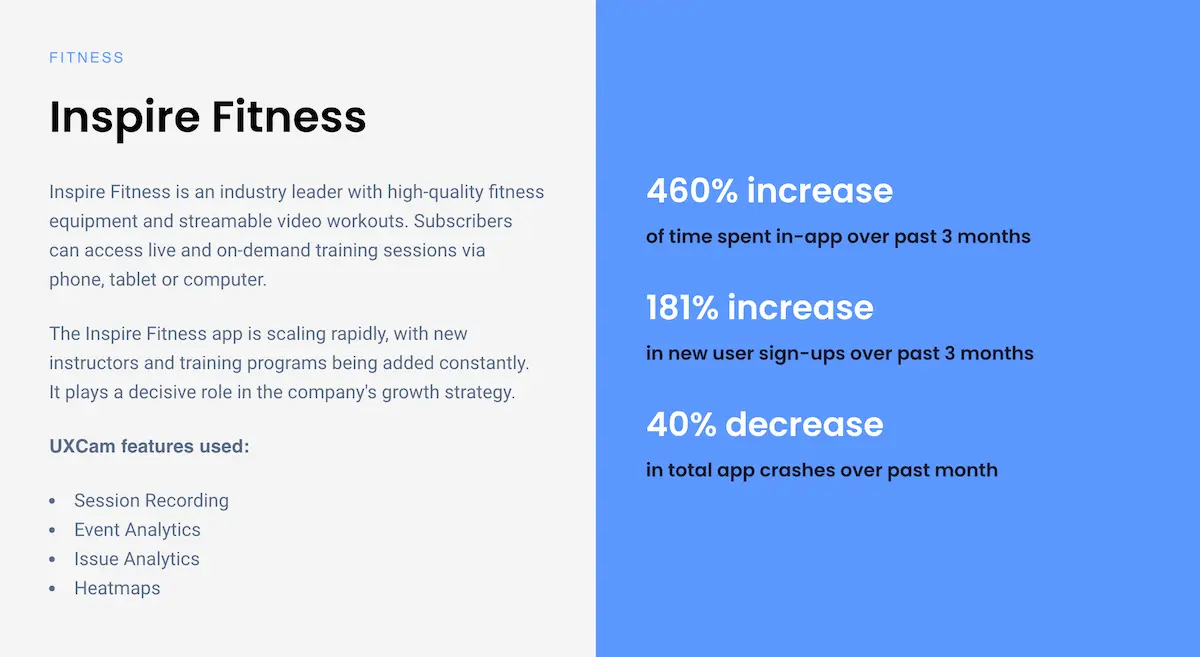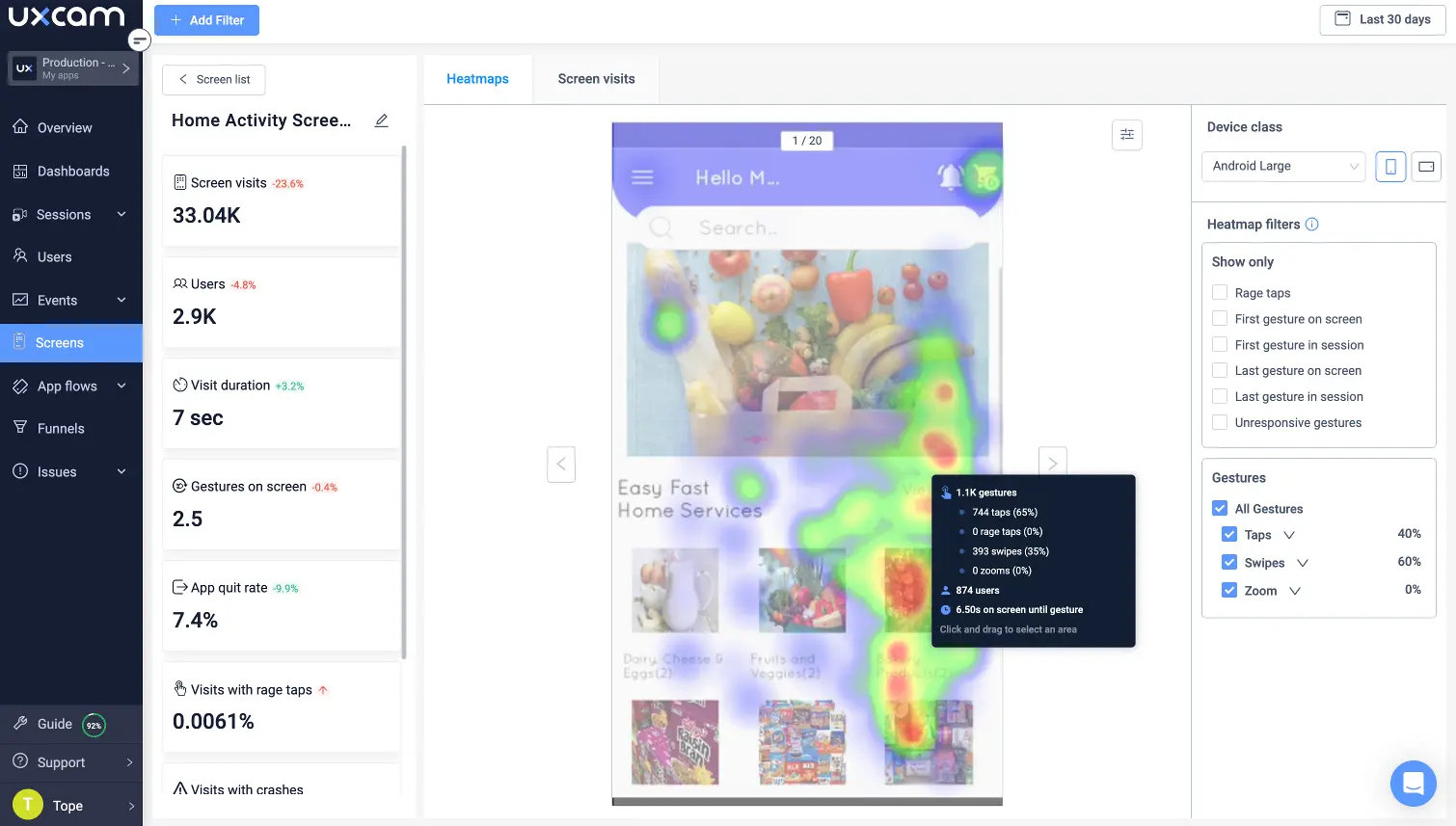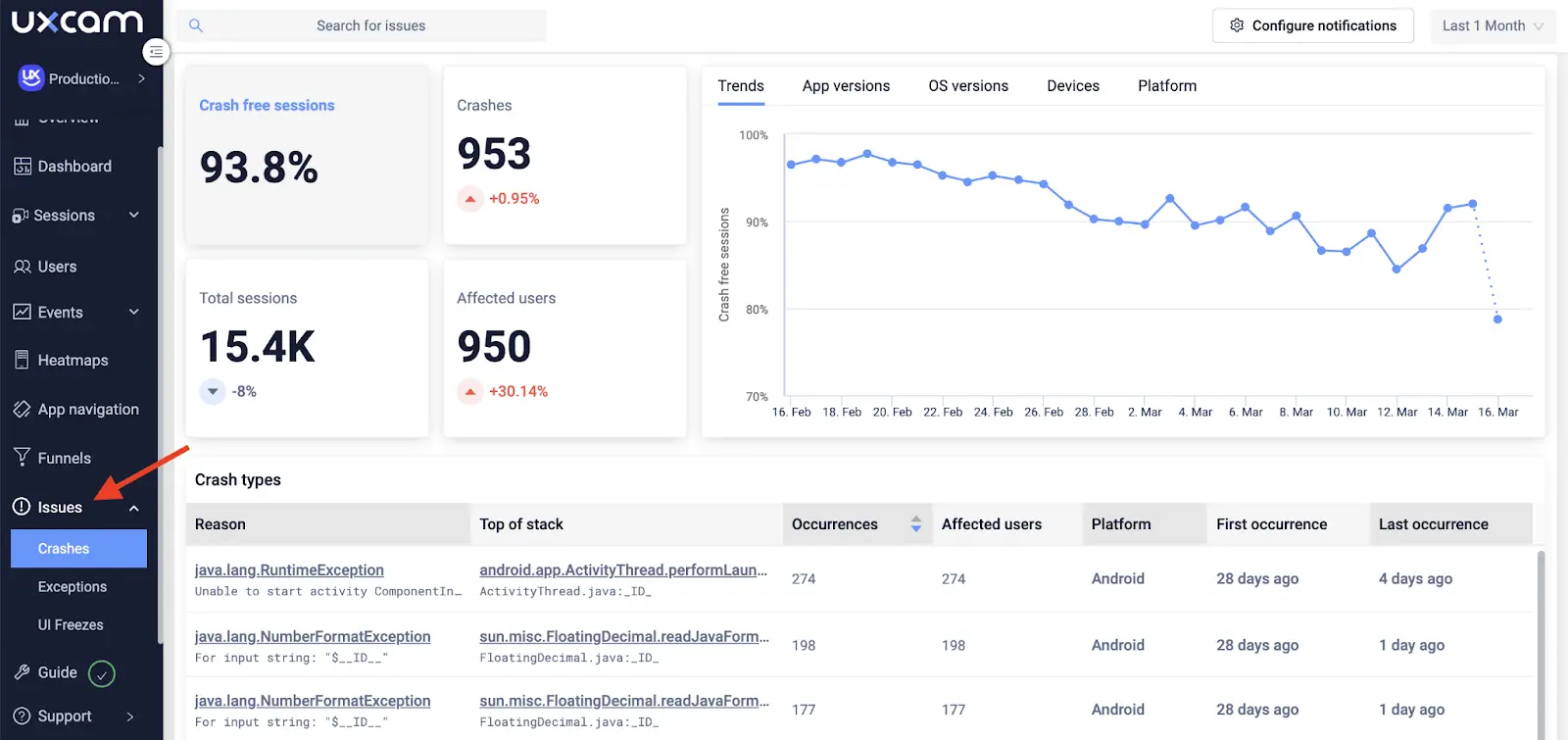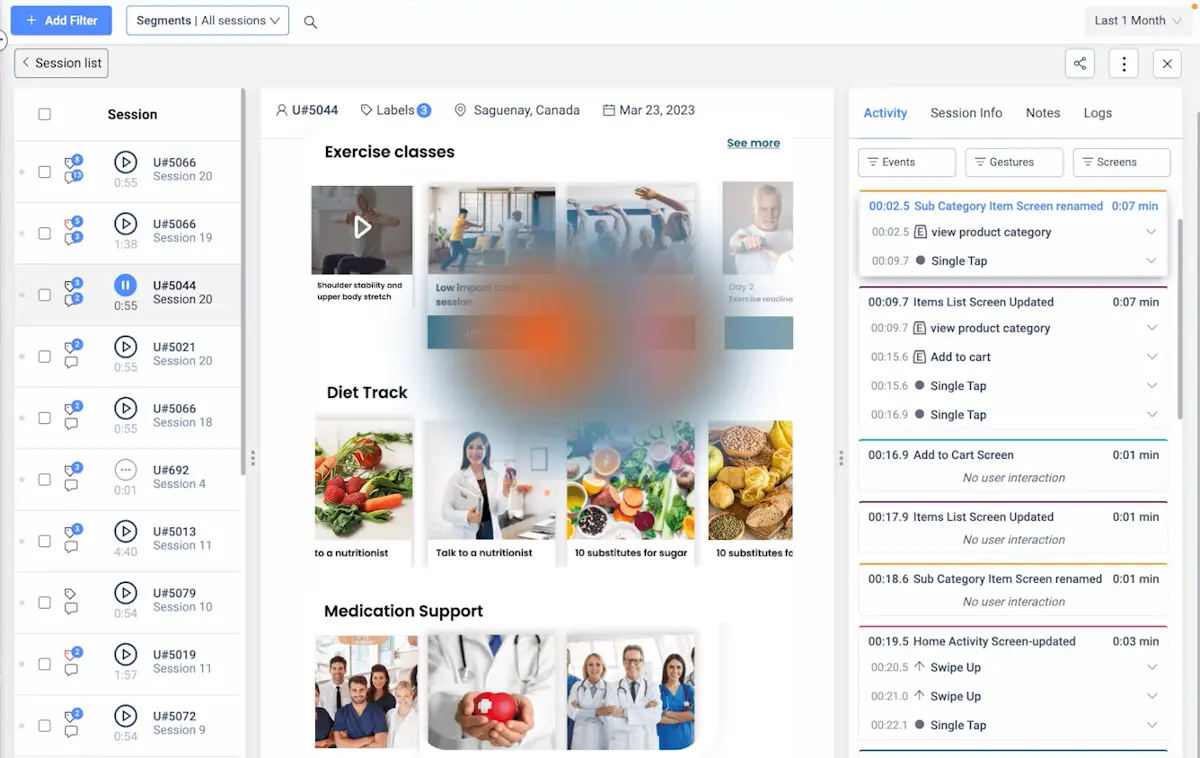Back to blog
6 MIN READ
Mobile App Optimization Techniques - Top 4 Proven Strategies
PUBLISHED
20 January, 2025

Product Analytics Expert
Mobile app optimization is essential for a great user experience—it improves user satisfaction and increases user engagement and retention. If your app is cumbersome or sluggish, 29% of smartphone users will seek alternatives.
At UXCam, we recognize the vital role of mobile app optimization in enhancing both user experience and business outcomes. Our goal is to empower mobile app development teams with effective knowledge and techniques for optimizing their apps, ensuring a smooth, engaging, and rewarding user experience.
Stay tuned as we explore four techniques to build better, more engaging products. Why listen to us?
At UXCam, we've helped thousands of product teams take a data-driven approach to mobile app optimization with features like heatmaps, session replays, and crash reporting. Our expertise has enabled companies to reduce churn rates, increase user retention, and drive overall revenue growth.
The bottom line—we know what works when it comes to mobile app optimization, and we're here to share our insights with you.
Summary - How to optimize apps
Implementing these strategies can significantly enhance your mobile app's performance and user experience.
| Optimization strategy | Description |
|---|---|
| Efficient code management | Write clean, modular, and reusable code for maintainability. |
| Reduce app size | Remove unused code and compress resources to minimize size. |
| Optimize images | Use appropriate formats and compress images without quality loss. |
| Minimize network requests | Aggregate and batch API calls to reduce latency. |
| Implement caching | Store frequently accessed data locally for quicker access. |
| Optimize UI/UX design | Ensure intuitive navigation and responsive layouts. |
| Lazy load resources | Load non-critical assets as needed to improve startup time. |
| Manage memory usage | Monitor and optimize memory allocation to prevent leaks. |
| Enhance app startup | Use baseline profiles to improve code execution speed. |
| Test on real devices | Regularly test on various devices to identify performance issues. |
| Optimize battery consumption | Minimize background processes to reduce battery drain. |
| Analyze user behavior | Use analytics to understand user interactions and preferences. |
| Monitor performance metrics | Continuously track key metrics to detect and resolve bottlenecks. |
| Optimize onboarding process | Simplify onboarding to enhance user adoption and retention. |
| Conduct regular testing | Perform usability tests to identify and fix issues promptly. |
What is mobile app optimization?
Mobile app optimization is the process of systematically improving the performance, visibility, or UX of a mobile app.
There are all kinds of related processes that fall under this umbrella, including:
App store optimization (ASO)
Performance monitoring
A/B testing
The overarching goal is to use data to make informed decisions about how to improve your app for users. In other words, mobile app optimization is all about understanding what makes users tick and then using this knowledge to optimize the app experience.
Mobile app optimization example: Inspire Fitness
For an example of mobile app optimization, consider Inspire Fitness.
The company needed to gain a holistic understanding of user retention and engagement across their integrated ecosystem of fitness equipment and mobile apps.
Although they had quantitative data tools like Mixpanel and Instabug, they lacked the ability to analyze qualitative data for meaningful insights into user behavior. This hindered data-driven decisions for fitness content on the app.

With UXCam's session recording, event analytics, issue analytics, and heatmaps, Inspire Fitness gained valuable insights into user behavior and engagement. This data-driven approach led to informed decisions, improved app performance, a 460% increase in user activity, and a 40% reduction in app crashes.
4 Mobile app optimization techniques
1. Analyzing user behavior
Mobile apps generate tons of user behavior data. Every tap, swipe, drop-off, and action leaves a trace—and with user data analytics tools like UXCam, developers can pick apart this data to identify trends and patterns that can inform optimization.
There are all kinds of tools that can help you analyze user behavior, including:
Heatmaps: For visualizing where users tap, swipe, and scroll on a large scale.
Session replays: For zooming in on individual user sessions and seeing their exact actions.
Funnel analysis: For identifying where users drop off in the conversion process.
Event analytics: For tracking specific actions taken in the app (like button taps).
PlaceMakers used UXCam’s session replay, heatmaps, and event analytics features to figure out why sales had plummeted since introducing a “constrained” tag to label low-stock products that may take longer to ship.
By zooming in on user sessions using session replays and heatmaps, the PlaceMakers team noticed that users were scrolling past products tagged as “constrained”—even though they matched their searches.

They hypothesized that their messaging around this feature was too strong (e.g., bold red font) and may have been scaring off potential buyers. They softened the messaging and sales quickly doubled.
2. App performance monitoring
Regular in-depth app performance audits are essential for identifying potential issues before they negatively impact users. UXCam can help you find issues that could potentially impact users negatively with features like:
Frustration monitoring: For tracking rage taps and dead taps that may indicate a user struggling to complete a task.
Issue analytics: For identifying issues like UX freezes and app crashes that are impacting performance.

In addition to these features, you should also think about using a dedicated mobile app monitoring tool like Dynatrace or New Relic for insights into metrics like load times and network issues.
3. Onboarding optimization
Onboarding is a key driver of user adoption. If users don’t learn how to gain value from your product quickly, many will abandon it. That’s why optimizing your onboarding experience is crucial for retaining users.
Costa Coffee is a great example of onboarding optimization.
When the multinational coffee brand launched a loyalty program along with a mobile app, they were surprised when a big percentage of users dropped off during registration. They turned to UXCam to uncover the root cause.
Costa Coffee's Global Digital Analytics Manager tracked custom events, visualized the registration process through funnels, and identified a 15% drop-off due to invalid passwords. Reducing the number of steps to reset a password by simplifying the flow resulted in an increase in successful registrations.

Additionally, you should consider:
Using tooltips and guided tours to help users navigate the platform
Streamlining the registration process by only asking for essential information
Providing clear and concise instructions throughout the onboarding process
Incorporating visual elements and interactive features
Ensuring compatibility with various devices and browsers
4. Regular testing
Regularly testing your mobile app is important to ensure functionality and performance. Thorough testing helps identify and fix bugs or issues before reaching users—and there are two main kinds of testing that are especially important:
Functional testing: This type of testing ensures that the app is functioning correctly and performing as expected. It involves testing all aspects of the app, including its features, buttons, links, and navigation.
Usability testing: This type of testing is more focused on the user experience. It involves testing how easy and intuitive it is for users to navigate and use the app, and if they encounter any difficulties or confusion.
Recora used UXCam to conduct usability tests for their mobile to understand why users kept complaining of bugs that didn’t seem to exist.
With session replays, the product team quickly discovered that many users with tapping and holding an important button that was programmed to be tapped. This meant that from users’ perspective, the app wasn’t usable.

Recora resolved this by enabling a press-and-hold gesture, reducing support tickets by 142% and improving the overall user experience.
Why is mobile app optimization important?
It enhances UX
90% of users abandon apps due to poor performance. Slow loading times, crashes, and unresponsive features frustrate users and lead them to abandon the app. Mobile app optimization targets inefficiencies and improves the overall user experience.
It boosts engagement
When users have a positive experience with an app, they're more likely to engage with it, spend more time using it, and even recommend it to others. The opposite is true for users with negative experiences—66% of mobile users believe that a negative user experience can adversely affect their perception of the brand.
It gives your app a competitive advantage
By optimizing your app, you can make sure that it loads quickly, functions smoothly, and provides a user-friendly interface. Plus, mobile app optimization can also improve your app's visibility in app stores, since app stores consider factors like app performance and user ratings when determining search rankings.
Conclusion
Mastering mobile app optimization is essential for delivering a seamless user experience and driving engagement.
By focusing on techniques like efficient understanding your user, streamlining your onboarding process, leveraging analytics tools like UXCam, and continuously testing your app. Businesses can not only stand out in the competitive app marketplace but also ensure sustained success.
Sign up for a free trial of UXCam today.
FAQs
Mobile app optimization FAQs
Why is mobile app optimization important?
Mobile app optimization improves user satisfaction, reduces churn, increases app store visibility, and boosts overall performance. A well-optimized app loads faster, ranks higher, and delivers a seamless user experience that drives growth.
What are the key areas of mobile app optimization
The Key areas of mobile app optimization are:
- App performance (speed, crash rate, responsiveness)
- User experience (UX) (navigation, design, onboarding)
- App Store Optimization (ASO) (keywords, ratings, visuals)
- Engagement & retention (push notifications, personalization)
- Analytics tracking (event tracking, user behavior analysis)
What tools are used for mobile app optimization?
Popular tools include UXCam, Firebase, App Annie, Adjust, and Mixpanel. These tools help track performance, analyze user behavior, monitor crashes, and optimize acquisition and retention strategies.
You might also be interested in these;
Product optimization - 5 Steps to deliver a better product
Customer journey optimization: 6 practical steps
How to build an effective product funnel
Conversion Funnel Optimization - A Comprehensive Guide
5 Effective strategies to reduce customer churn
Top 9 mobile app retention strategies to enhance stickiness
UX Optimization: 4 Steps to deliver a better user experience
AUTHOR

Tope Longe
Product Analytics Expert
Ardent technophile exploring the world of mobile app product management at UXCam.
What’s UXCam?
Related articles
App Analytics
Mobile App Tracking: Practical Guide & Best Tools [2026]
The best tracking tools for mobile...

Jonas Kurzweg
Product Analytics Expert
App Analytics
Top Analytics SDKs 2026
Pick the right analytics SDKs to improve your app's...

Jonas Kurzweg
Product Analytics Expert
Product best practices
8 Best UX Analytics Tools and Software We’ve Tested 2025
A good UX design is key when it comes to user satisfaction. Learn about five of the best UX analytics tools you can use to get valuable insights about user...

Jonas Kurzweg
Product Analytics Expert


